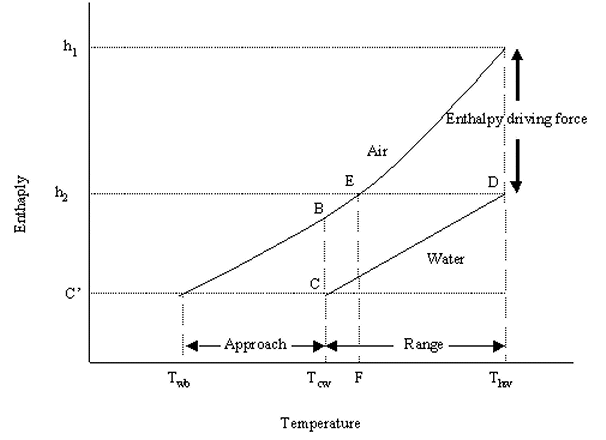• the value of NTUm for design conditions is calculated; • the line of slope n and constant C is plotted and adjusted on the design point; • for other operating conditions, determined by the fluid flows, the abacus allows us to find, at abscissa L/G and on the tower characteristic line, the new values of NTUm and approach, which determines the outlet water temperature and therefore the capacity. The air outlet temperature is deduced. For another cooling or other air wet bulb temperature, it is possible to recalculate another abacus. Knowing the values of variables (NTUm, L/G) from the original chart, we get the new approach. It seems necessary to warn the reader: we tried to implement this approach on some experimental data either provided by the manufacturers or that we were able to get, and we realized that, when applied to NTUm, the correlations of the type Merkel lead to accurate reconstructions with values n and m close to those we have indicated. However they may be different when we use an (epsilon, NTU) approach similar to those of dry heat exchangers.
33s000chd free download. Get your warez here, do not pass by, here we are giving all of them for free to everyone who want them. To be more precise, we are giving links to file hostings, which store them. 33s000.chd Free Download. Now download a file called 33s000.chd. Here's the link This needs to go in the CHD folder. Then download a file called sf33usa.bin.
Delta Cooling Towers, Inc. Tower selecting program is available online to assist in Selecting & Sizing Cooling Towers. / 500 X GPM The Design GPM and the ° Range of cooling are directly proportional to the Heat Load. Back to FAQs & Definitions.
We recommend extreme caution when using this analogy, and think it is better to apply the Merkel model which has been proven and is used by the profession. The calculations are slightly more complex, and can be made with small programs or Excel macros.
Revised March 2017 A suite of cooling tower applications that is indispensable to anyone responsible for the peak performance of cooling towers. Applications include, Air Properties Calculator, Merkel Number calculator, Demand Curve Worksheet (calculates tower performance & characteristic curve test method) and Mechanical Draft Tower Performance Test Analyzer (performance curve method). The performance test analyzer compliments the ATC-105 cooling tower test code. Many fully explained examples presented in the help files.

Educational pricing & site licensing available upon request. Toolkit v3.1 is Windows Vista and Windows 7 compatible. To view screen shots. To download a demo.
To view order form. Why you need the CTI ToolKit? • Thermal Design Worksheet.
An interactive, graphical worksheet designed to speed cooling tower thermal calculations. Set your own values for wet bulb, range and altitude, and plot your own demand curve on virtually any printer. • Performance Evaluator.
Evaluates induced draft counterflow and crossflow cooling tower performance with field acquired data. Fully compliant with the latest CTI ATC-105 test code (performance curve method). • Air Properties Calculator.

Fully ASHRAE compliant, using latest psychrometric property routines. • Detailed Help Files. How-to-use help for typical applications is just a click away. What does the CTI ToolKit do for me? • Predicts off-design performance with the Demand Curve Tab application. Answers what-if questions like, how much will my leaving water temperature change if I increase my waterflow 10%?
Decrease my range 15%? • Evaluates cooling tower performance and acceptance tests. • Performance Curve Tab: application allows the automatic calculation of cooling tower performance using the performance test method of the CTI ATC-105. Automatically solves the iterative calculations for the exit air temperature and psychrometric properties to compute the test L/G as required by CTI ATC-105. Accurately interpolates between curves and generates all the necessary crossplots to determine the overall Tower Capability. • Demand Curve Tab: application speeds the evaluation of the characteristic curve method.